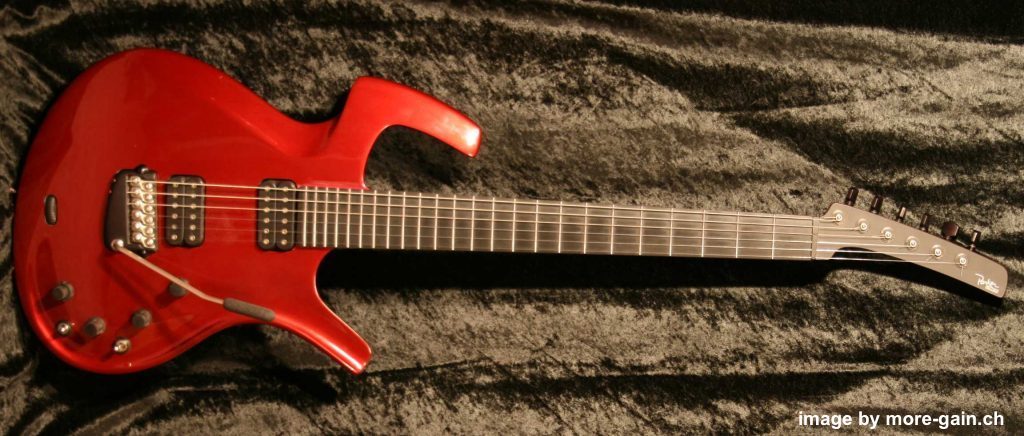10 Guitars You Need to Know #8: Parker Guitars
Author: Lucas Frost


Table of Contents
Parker Guitars:
The High-Tech Parker Fly
Electric guitars are a product of technology, namely the electro-magnetic pickup, and technological developments have been a prime driver of guitar design and quality.
But essentially, the main principle behind guitar building techniques remained static since the 1950s. One man believed it was time to change this – Ken Parker. By using new materials and renegade design, the Parker Fly is really a surprising little beast.
Guitars can be made out of all sorts of materials: aluminium, plastic, paper or even concrete guitars pop up occasionally. But wood remains the most appealing, because of its natural look and feel, good strength-to-weight ratio and not least, for its pleasant tonal characteristics.
Parker took wood one step further: ignoring many conventional manufacturing techniques, Parker and fellow boffin Larry Fishman set out in the early 1990s to reinvent the guitar.
It would be easier to play, have better tuning and sustain… but crucially, the guitar was to be lighter. The result was a re-thinking of material technology, yielding a guitar ‘as light as a fly’. It became… the Parker Fly!
What happens when you cross a boat with a guitar?
So Ken Parker wanted to make his guitar lighter than standard electrics. He started off experimenting with different tonewoods, shaving surplus wood off the body to save weight. When he saw a friend of his use carbon fiber to repair speed-boats, he began experimenting with this new material in conjunction with the wood.

The resulting guitar was made of a composite, with a carbon fiber exoskeleton providing the rigidity, and a core of traditional hardwood to give the instrument its characteristic tone. Depending on the model, this could be anything from warm mahogany to crisp ash or (strangely) a softwood like spruce.
The same approach was used on the neck and fretboard, which again wraps a central hardwood core in strands of carbon and epoxy resin. The carbon fretboard is very hard and smooth to play, while the neck becomes extremely rigid, and can be made thinner for easier, faster playing. In addition, Parker necks are “seasonally stable” (i.e. impervious to the atmosphere’s fluctuations in temperature and humidity) and stay in tune almost perfectly. Finally, the carbon-based composite makes Parker guitars far lighter, weighing as little as 2kg!
Pickup possibilities

The Parker Fly has two humbucking pickups, made by the reputable DiMarzio or Seymour Duncan brands. Either humbucker can be ‘split’, thus offering a range of aural options from crisp and precise (single-coil) to fat and warm (humbucker).
On top of this immense palette of options, Parkers also include Piezo pickups, which transmit the acoustic sound of the strings. These receptors are built into the bridge and receive the physical vibration of each string. This sounds very similar to an acoustic guitar, and can be combined with the normal electromagnetic pickups. You can even play each type of pickup through a different amp using the stereo output – how cool is that?
High-Tech Hardware
With such a meticulous, high-tech construction, it comes as no surprise that the Fly’s hardware is similarly advanced. Take the tuners for instance: six Sperzel Locking Tuners adorn each futuristic headstock, shaped in such a way to improve the guitar’s overall resonance.

These tuners have a special construction that clamps each string into place – they now need fewer windings to secure the strings, which is convenient and helps with tuning stability.
The bridge of this guitar is equally innovative. Featuring a flat plate-spring rather than normal coil to fit into the thin body, it can be easily adjusted to suit different string gauges and retains its tuning better. But it does more! You can switch it from free-float mode (bending up or down) to down-only (handy incase a string breaks) or fixed mode.
Even the fretwire is different, using stainless steel instead of traditional nickel alloy frets. In theory you never need to replace them. (Luthiers don’t use stainless steel because it’s a real hassle to work with – it ruins fretting tools.) But although stainless steel is convenient, these frets have the tendency to wear out the strings much faster, so you’ll get through strings faster…
Too advanced?
So what does it all add up to in practice? The playing experience really is amazing – many guitarists find themselves able to play stuff they never thought possible. The light weight, balance and body contouring make this one of the most comfortable guitars out there. And it stays in tune. Fly aficionado Adrian Belew, a superb but little-known guitarist who played with Frank Zappa and King Crimson, explores the limits of sonic expression using a Parker Fly. For him, the Parker Fly plays like something out of this world.
Soundwise, the Fly offers a very broad spectrum of timbres, and can be very expressive with its excellent vibrating bridge. But some guitarists associate the Fly’s thin body with a thin tone, despite the humbucking pickups. While it will never get the fatness of a Les Paul, ‘thin’ is arguably the wrong way to think about it. I prefer ‘too perfect’. Imagine it as the difference between vinyl and digital music. Digital actually sounds a lot clearer, with less noise and a more refined tone; but vinyl has that warm voice, its crackle adding life to the music. So whereas a Fly sounds more high-fidelity, many other guitars might have more character.
That is my explanation for why the Parker Fly has not taken over the guitar world – I rarely see them in a music shop. Granted, the Fly is not the cheapest guitar, and some players might dislike its sleek, modern looks. But if it has so many improvements, surely it’s worth the money?
Probably, Parker guitars are a little too advanced, and take away some of the fun of playing. Sonic impurities are often what make a song “musical”, adding character, colour and personality. So although these are doubtlessly some of the best guitars out there, I cannot help thinking that the quest for perfection may have taken away some of the soul…
Thanks for reading this article! If you’re still on the prowl for the perfect guitar for you, or maybe want to scan a few free lessons, then you should browse around our blog. We’re always adding more and more articles on the latest trends and topics like its only love chords, common blues chord progressions, and pompeii guitar chords.








How adorable